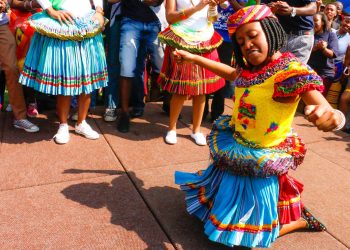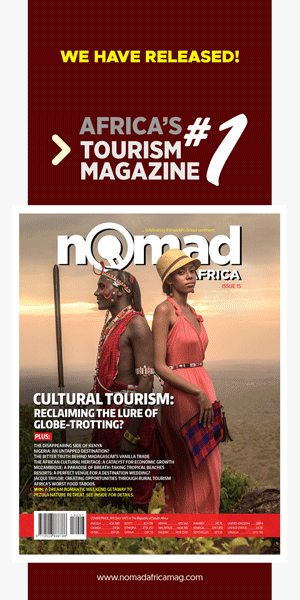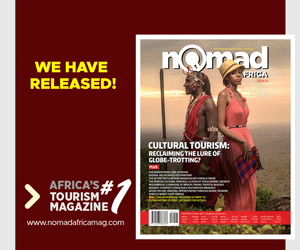It is really common to see most Africans adorned in different bead works, it is part of our culture that most of us still embrace. It is an immemorial custom passed from one generation to another. Fancy beadwork costumes and body ornaments were traditionally created for day to day use. They were used in traditional ceremonies, or to celebrate matrimony and the rites of passage from childhood to adulthood. Bead work also provided a source of income and livelihood for hundreds of street salesmen and craftswomen who create beaded dolls, necklaces, anklets, collars and belts. This is why beads are one of the most riveting and historic symbols in African culture. Bead works are not only beautiful but they have different meanings and significance behind them. Each bead, shape and color tells a different message. Many African tribes have their own unique designs and it is fascinating to see how different African tribes used beads to relay different messages.
The Nbebele is a Nguni ethnic group native located in South Africa. They are mostly well known for their outstanding craftsmanship, their decorated homes, and their distinctive and highly colorful mode of dress and ornamentation. Bead work plays a huge role in their dressing from an early age as they use it to mark the different cultural stages of a woman’s life. The focal element of Ndebele women’s wear is an apron. Young girls adorn small beaded aprons. This distinct skirt is formed from a firm, folded canvas strip that would be tied around the waist, with an upper band of beads embellished directly onto this surface. Hanging from this top band is a lace-like bead “cloth” assembled from individual bands of beadwork. This is constructed to fall in front of the thick row of cotton cords threaded with white-seed beads that comprise the skirt itself, increasing the dimensionality of the garment and encouraging the play of light when seen in motion—an expression of ebullience.
Older girls who have undergone ignition wear isiphephetu, a beaded apron given to them by their mothers. The skirt is made of a large oval-shaped portion of leather, overlaid with a row of long strands of white beads, and prettified at the top with a multi-colored geometric pattern and three roles of brass rings. This particular skirt is normally tied at the waist and worn over the buttocks. The leather hide is intended to draw attention by hugging the buttocks and hips, and the swaying of the beads adds to this affect when the woman moves.
During the marriage and initiation ceremony, the bride wore an isiyaya(bridal veil) to hide the woman’s face during the transition from one state of being to another. Apart from the veils, Ndebele brides also wear long trains called nyoga, which are made of white beads woven together with string by their female relatives. The patterns, length and structure of the nyoga veil meant to express things such as whether the bride will be the groom’s first wife, or if she is still a virgin.

A married woman traditionally wears a blanket over her shoulders with a lot of thick beaded hoops of twisted grass called isigolwani which are thick beaded hoops worn around their necks, arms, legs and waist. They also wear copper and brass rings or “dzilla” around her arms, neck and legs. The blanket or “nguba” is normally one with stripes of green, red, blue, yellow and brown. Married women also adorn some form of head covering as a sign of respect for their husbands. These vary from a beaded headband or a knitted cap to elaborate beaded headdresses called “amacubi”. Beads used for married Nbebele women had a more refined palette and used colors, materials and patterns mostly associated with fertility and prosperity.
These beads traditionally incorporated colors in order to communicate information about the wearer: her class, the ties that she has to other women in her community or family who made the attire, and her interest in marriage and family. Owing to the fact that the relationship between generations of women is so deeply significant to the process of making these garbs, ideas of what it means to be a woman in Ndebele culture, and who a person is in the social status of their community are literally and figuratively woven into the designs of these garments.
For the Ndebele men, their clothing was less colorful. Traditionally, the Nbebele men wore a breast-plate or “iporiyana”, which hangs from the neck. It is usually embellished with beads around the top and is made from hides. The “iporiyana” is a symbol of virility and is given to a young boy by his father after he has undergone initiation which hangs from the neck. It is frequently bedecked with beads around the top and is made from animal skin. Ndebele men wore ornaments made for them by their wives.

Traditionally, the Nbebele use locally available materials such as shells, metals, and animal bones and hides in making these beaded clothes and ornaments. They chose specific materials in regard to their relation with symbolic or spiritual nature, or their abilities to protect the wearer and promote their social status. Currently, much of Ndebele beadwork is made of glass or plastic beads. Nevertheless, the main significance that beadwork has in the lives of women, and the way that meaning is expressed through colors, geometric patterns, and movement continues to still resonate through these new materials.
Beadwork was a discernible means of highlighting an ethnic group values and identity as well as communicating status and the passing of rites. Among the African tribes, beads encapsulates beauty, tradition or culture, strength, marital status, age, power and warrior-hood. In the Nbebele native group, their women wore these beaded pieces as a sign of wealth, marital status, health and to denote the number of children they have. In modern Africa, the meaning and symbols of beadwork have changed, but it is still used to show our pride in our African identity.





















